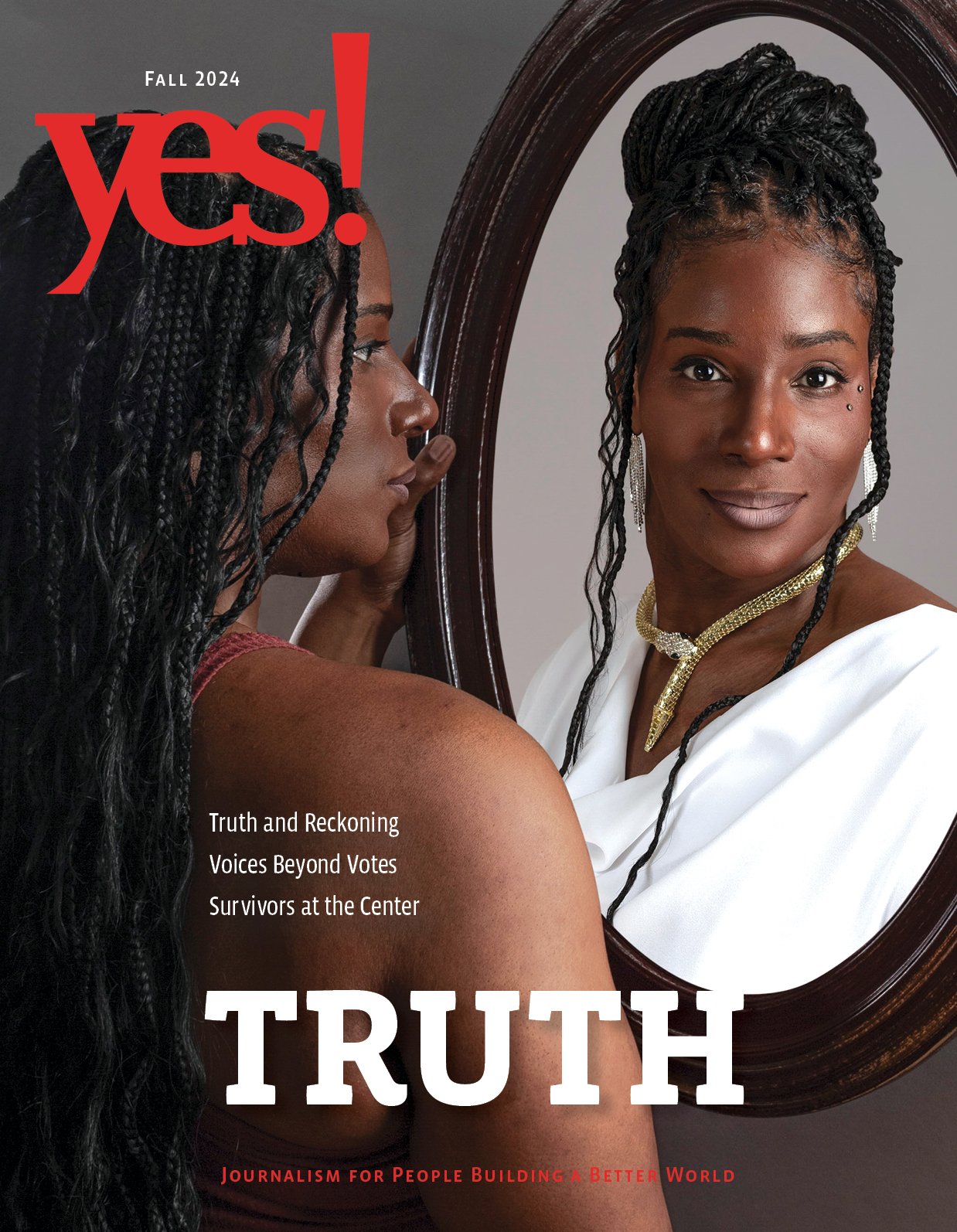The Makah Tribe Is Calling Back the Whales

A single road provides access to the town of Neah Bay, Washington, on the Makah Reservation—a narrow ribbon of asphalt that skirts the lush cloak of evergreen skyscrapers called the Olympic Rainforest. As we get closer, I see the waters of the Strait of Juan De Fuca to the north flowing into Puget Sound. This location on the northwest corner of the Olympic Peninsula places the Tribe precisely where prevailing currents converge, bringing eastern North Pacific gray whales near shore as they travel in yearly migrations.
I undertook the five-hour drive to Neah Bay from Tacoma, Washington, with fellow Indigenous allies and friends of the Makah Tribe to celebrate Makah Days, a yearly three-day festival celebrating the 1924 granting of U.S. citizenship to all Native Americans.
But this year, Makah Days held an additional significance. Not only was it the 100-year anniversary of the first festival, but it was also the first celebration after the Tribe’s victory in their decades-long struggle to legally resume hunting gray whales.
When night falls on my first evening here, fireworks explode in the sky over Neah Bay. A steady rain pats our faces as we look up at the display. Each explosion proclaims freedom to the darkness—the freedom of the Tribe to finally practice food sovereignty once again.
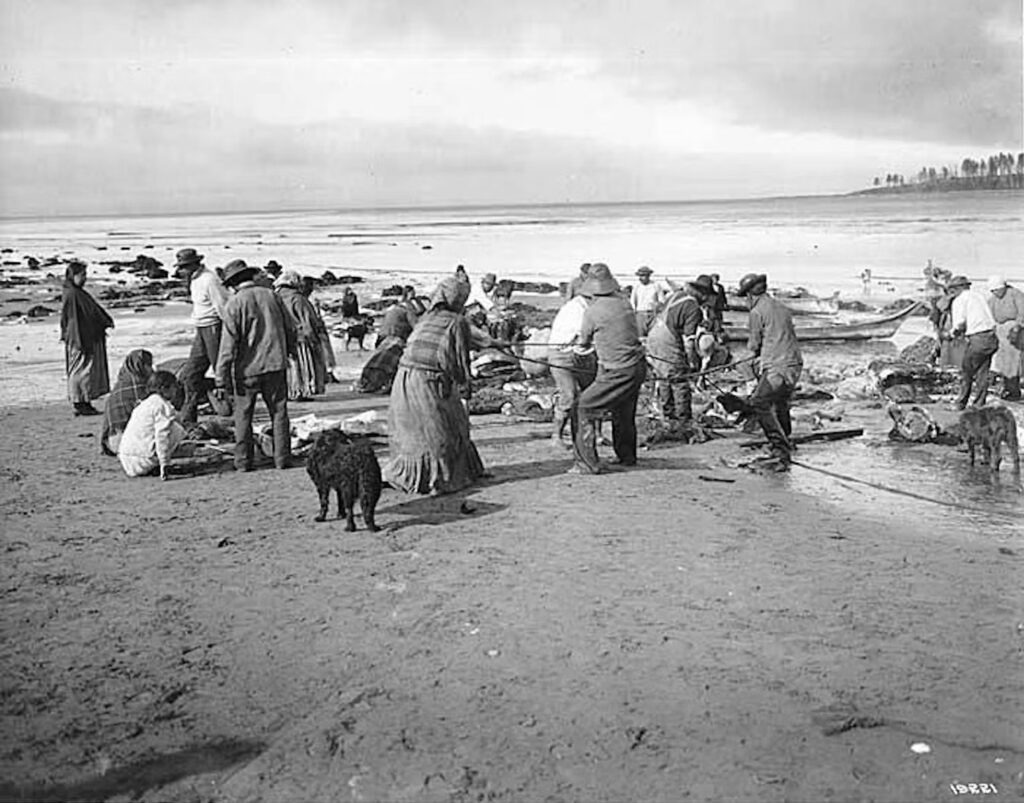
Physical and Spiritual Health
The Makah is a marine-based Tribe. Their history and identity are tied to the sea—as are their traditional foods.
Archaeological evidence at the site of the ancient Makah village of Ozette indicates the Tribe’s whaling tradition goes back at least 1,500 years, probably earlier. It’s so important to their identity that the Tribe gave up vast areas of land when they signed the 1855 Treaty of Neah Bay in exchange for keeping the right to hunt whales. They are the only tribe guaranteed this right by Congress.
But over the decades that followed, commercial whaling operations decimated whale populations. To protect the whales and honor their sacred connection with them, the Tribe voluntarily stopped hunting whales in 1928.
With the loss of this practice went the health benefits. Sea mammal fats are high in n-3 fatty acids that are essential for fighting cardiovascular disease and Type 2 diabetes, as well as having many other health benefits.
“We’ve seen a growing epidemic of lifestyle disease among our communities such as Type 2 diabetes, cardiovascular disease, autoimmune disease, a rise in obesity in our communities—not just in adults, but in youth as well,” explains Charlotte Coté (Tseshaht/Nuu-chah-nulth), Ph.D., a professor in the Department of American Indian Studies at the University of Washington.
The Makah are hardly the only tribe to suffer this way; the destruction of traditional foods, most notably the buffalo, was part of a continent-wide effort to eradicate Indigenous peoples. Boarding and residential schools took traditional Native foods away from children and replaced them with highly processed foods. This weakened the cultural connections the people felt and opened the door to health problems.
Even when the Tribe wasn’t whaling, the spiritual connection between the Makah and the whale spirits was kept alive in the form of sacred whaling songs. “Chiefs obtained their whaling songs through a connection with whale spirits that they encountered in dreams or during a whale hunt,” writes Coté in her book Spirits of Our Whaling Ancestors: Revitalizing Makah and Nuu-chah-nulth Traditions.
These songs reinforced the connection between the chiefs and the whales they hunted. The songs are sacred property that belong to the chiefs and their people. They are more than simple tunes or even prayers. They are an auditory manifestation of the sacred relationship between the Makah and the gray whales.
And these songs were practiced for the decades when hunting itself was not.

To Revive a Tradition
The Makah’s treaty-guaranteed right to whale was last officially invoked 25 years ago. It was prompted by the 1994 removal of the eastern North Pacific gray whale from the federal list of endangered wildlife.
Makah member Theron Parker and a whaling crew prepared for months, not just physically but spiritually, by praying and performing sacred rituals at secret locations on the reservation. Hunting a 30- to 33-foot giant of the sea, with eight men in a wooden canoe, requires spiritual as well as physical strength.
On May 17, 1999, Parker heaved a harpoon into the back of the first gray whale his Tribe had hunted in more than 70 years.
After a second harpoon strike, the whale’s suffering was ended with a shot from a high-powered rifle fired from a support boat. Without this, a whale’s death could last hours. Parker, who is a descendant of a great Makah whaling family, then led the eight-man crew of the whaling canoe Hummingbird in a song releasing the whale’s spirit back to the sea.
When they towed the whale to shore, they were met by hundreds of Makah and their supporters. Polly Debari, Parker’s partner at the time, joined the procession of whalers making its way through the jubilant crowd.
Debari was as much a part of the whaling crew as the rest of them. She and several other young women of the Tribe performed the vital task of observing a sacred ritual during the hunt. In 2019, Debari submitted a declaration of support for Makah whaling to the National Oceanic and Atmospheric Administration (NOAA) in which she described the ritual: “Generally speaking,” she writes, “my role was to lay still while Theron was out whaling. In this way I was ‘becoming the whale’ according to our tradition.”
This blending of identities through ritual and prayer guided the whale to the whaling crew. Video from a news helicopter shows the magnificent giant gliding to the left just under the Makah canoe’s bow when Parker hurls the harpoon. The Makah believe the whale gave herself to the Tribe.
Debari was then free to move as the creature she had spiritually merged with was brought ashore. The community worked together, pulling the massive beast onto their land. The whale was butchered and its meat and blubber were served to the Tribe and its guests at a massive feast.
The Tribe’s most recent hunt was a celebrated revival of tradition for the Tribe.
“It reinvigorated the purpose of our culture,” Micah McCarty, a former chair of the Makah Tribe and speaker at a recent Living Breath of Indigenous Foods Symposium, which was co-founded by Coté, says. “In doing so, it’s inspired a lot of people to be involved in [our] culture.”
McCarty, who is the great grandson of Chief Hiškʷi·sa·na·kši·ł or Hishka, one of the last great hereditary chiefs of the Makah, notes how youth of the Tribe became inspired by the resurgence of interest in their people’s whaling tradition. The skeleton of the gray whale harvested in 1999 is now housed in the Tribe’s museum.
“We have younger generations now that are leading the Makah Days songs and dances,” he explains. “The last generation that once led that are now sitting back and watching the fruits of their success in grooming succession.”
A lot of that success relates to food sovereignty for the Makah. “Food sovereignty embodies that real, deep spiritual appreciation for food as a sacred gift,” Coté says. “At its most basic, it is really reinforcing those sacred relationships that we have to our world, including the plants and animals that give themselves to us as food. This is why the recent waiver for the Makah is very, very important, because it really is around food sovereignty that the Makah regain the right to access a very healthy food.”
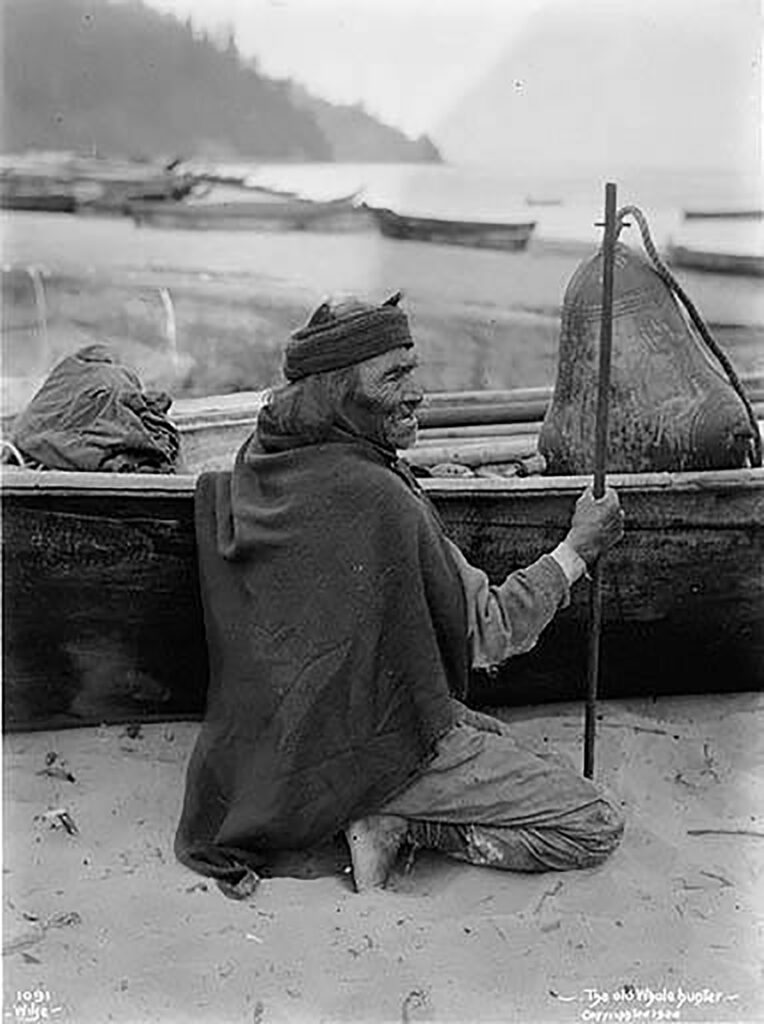
The Harassment by Animal Rights Groups
Despite the health and cultural benefits garnered by the whale hunt in 1999, the practice was soon stifled once again.
Members of animal rights groups, including Greenpeace and Sea Shepherd Conservation Society, harassed the Makah community and the whaling crews and even made death threats to tribal officials.
“Save the whales, kill a Makah” read signs at an anti-Makah whaling rally on the day of the 1999 hunt. McCarty, who has become a prolific Makah artist, points out how this attitude is both racist and un-American.
“We don’t impose our spirituality on other people,” McCarty states. “We’re not evangelists. It’s an American value to have a freedom of religion and a freedom of who we are. It’s inherently un-American to be anti–Makah whaling.”
On the second day of my visit to Neah Bay, I stroll along Bayview Avenue perusing the stalls that sell Native artwork and baked salmon, another Native food whose right to harvest is guaranteed to all Washington tribes by treaty. People smile and say “Happy Makah Days” as they pass.
Before long, the Makah Days parade begins. Men in military uniforms at the head of the procession carry flagpoles with Makah and American flags waving. No anti-American sentiment is evident. Many of the Tribe’s elders served in the military and some fought in foreign wars. They are proud to be American and proud to be Makah.
Still, in 2002, the 9th Circuit Court of Appeals bowed to pressure from animal rights groups and revoked the Tribe’s authorization to whale, demanding a new environmental impact study be performed. And so, despite the Tribe’s treaty-guaranteed right to hunt whales, they refrained while the studies were performed and decisions were made.
Two and a half decades after the 1999 hunt, NOAA’s environmental impact study shows that Makah harvests would have no significant impact on the population of gray whales. And so in June 2024, after decades of Tribal advocacy, NOAA granted the Makah Tribe’s request for a waiver from the Marine Mammal Protection Act. The Tribe can now harvest, on average, two to three eastern North Pacific gray whales per year, up to 25 total, over the next 10 years.
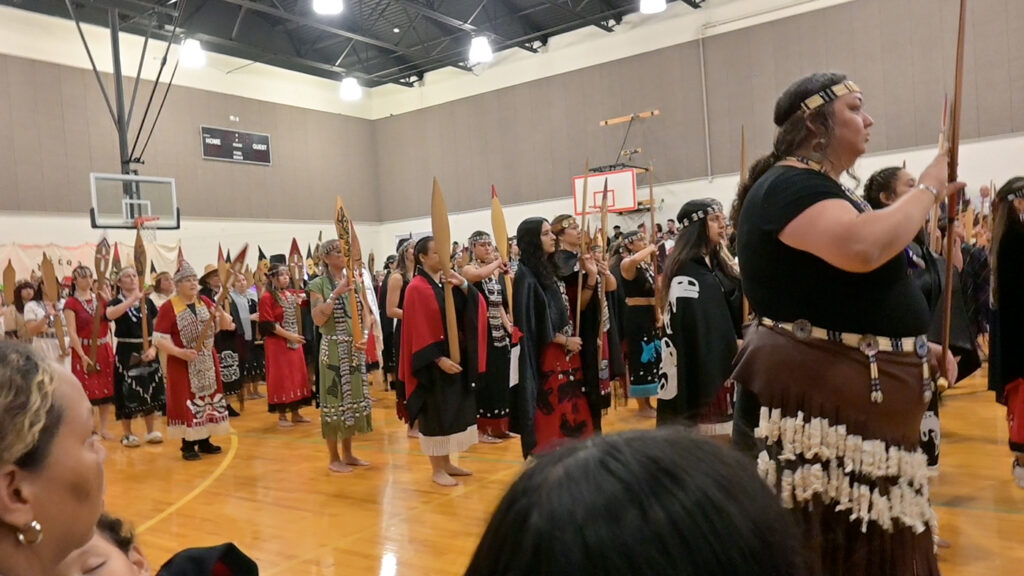
The Tribe Calls the Whales Back
On Saturday night, my friends and I go to the Makah Community Gym to witness sacred Makah dancing and the singing of sacred whaling songs. The bleachers are packed. The floor slowly fills with more than 200 Makah members in beautiful handmade regalia, many featuring images of the giant deity Thunderbird carrying a whale to the Makah people.
According to oral tradition, Thunderbird saw the Makah people were starving one winter and captured a whale to feed them. Saved from death by a sacred gift from the deity and by the whale’s sacrifice, the Makah honor all gray whales.
On the gym floor, each member holds a hand-painted canoe paddle that they use to mimic pulling a canoe through the sea that defines their people. When the song ends, the dancers all hold their paddles straight up. This is traditionally done when a canoe skipper calls “Paddles up!” to his or her canoe family as they approach a Native village. A Native canoe must wait until the leaders in the village call them to shore before they can land.
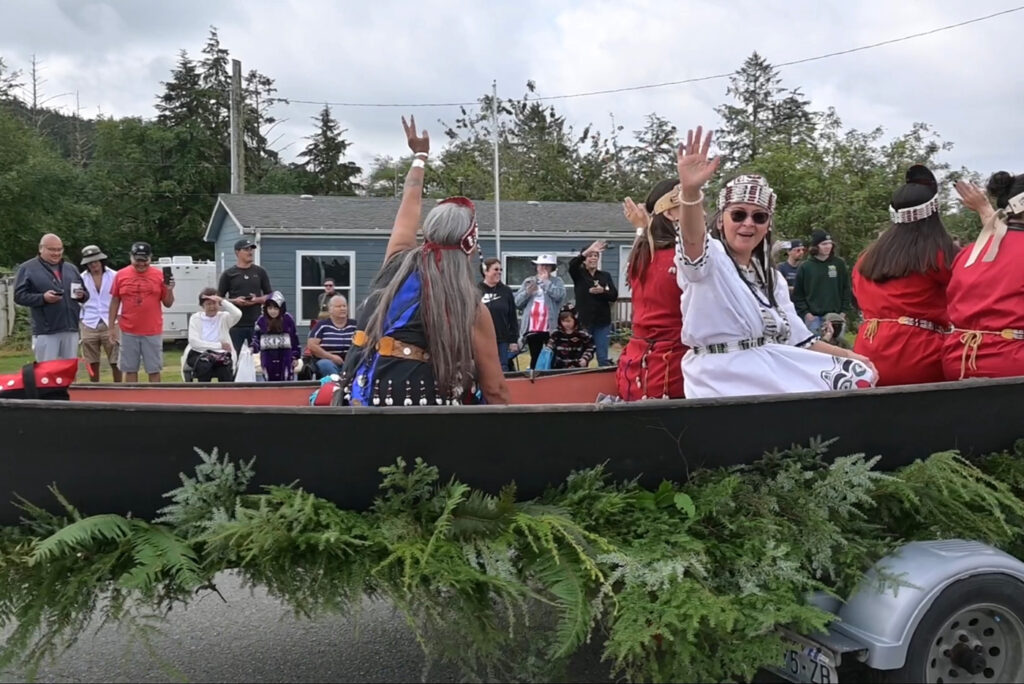
In much the same way, the Makah waited more than 70 years before the conditions returned for them to resume whaling. Then they waited another 25 years after animal rights groups challenged that treaty-protected right. Finally, this past June, NOAA finally cleared the way.
The Makah wait now only for the migrating gray whales to return.

|
Frank Hopper
, Tlingit, is a freelance Native journalist born in Juneau, Alaska, now living in Tacoma, Washington. His work appears in Last Real Indians, The Stranger, and Indian Country Today. His self-titled YouTube channel features videos about Native issues. He can be reached at [email protected].
|
